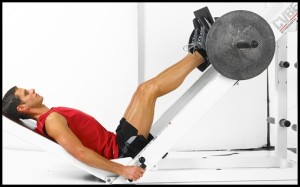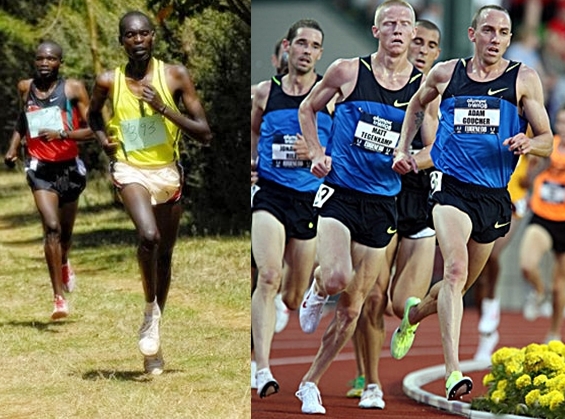Roughly speaking, strength training for forefoot running is not a requirement since forefoot running operates more as a spring-system that involves more use of the tendons rather than the leg musculature.
What researchers are finding is that small to moderate amounts of strength training is acceptable, however too much strength training sabotages running economy.
 According to a recent study by Doma and Deakin, excessive strength training before running hampered running performance:
According to a recent study by Doma and Deakin, excessive strength training before running hampered running performance:
- strength training impaired muscle force capacity for as long as 48 hours after training
Strength training was also found to interfere with the quality of a subsequent endurance training session.
Other work demonstrated that strength training impaired running economy by causing difficulty in optimizing endurance adaptation if strength training was continual.
- optimal endurance training performance was compromised due to residual fatigue brought on by concurrent strength training
- strength training before endurance training impaired running performance the following day to a greater degree compared to endurance training before strength training
In all, an endurance training session within 48 hours of a strength training session sends the muscles into a pre-exhaustive state due to residual fatigue from the preceding strength training session.
East African Elite Runners Aren’t Buffing Up
Big, strong, leg muscles are not necessary for forefoot running.
Notice how slender Kenyan and Ethiopian elite distance runners are? Weight training is not a major priority in their training regimen. They just RUN.
East African elite distance runners outperform even though non-African distance runners look physically stronger -most are ripped. Perhaps a more slender body frame equates to greater running efficiency? It sure does since muscle mass is heavy.

Above, notice the elite East African runners have less muscle mass than elite non-African runners. Yes, it’s relevant to point out that East Africans are genetically built to be more slender in appearance, but if muscle strength was essential in running, why aren’t East African elite runners buffing up like the American runners?
Why do runners in North America focus a lot on strength training? To avoid injury and improve mechanics, right?
Assume a runner never encountered injuries and had great biomechanics, in theory strength training would not be necessary.
But consider this, many East African runners are habitual forefoot runners as a function of running barefoot throughout childhood and adolescence.
Forefoot running has been shown to reduce peak ground reaction forces and shock attenuation compared to heel strike running, thereby lowering the likelihood of injury. Many recreational runners heel strike and roughly 75% are injured each year.
East African runners appear to suffer less injuries and typically compete in more races per year. Why? #1 forefoot running may be safer on the body, and 2# running barefoot strengthens the feet and legs.
East African runners may have sufficient lower extremity strength from running barefoot and by running on their forefoot, not their heel. The predicted outcome from running forefoot: less injury, less time pumping iron.
The Take Home Message
If you run correctly, you wont get injured. Running with a less forceful foot strike will protect your body from health harming impact shocks and may dramatically reduce the frequency and severity of injuries related to heel striking.
Less time should be spent strength training, and more time should be spent improving foot strike mechanics.
More great stuff on forefoot running:
- Forefoot Strikers vs Heel Strikers: Who Gets Injured More?
- Forefoot Striking May Be The Safer Way To Run
- How to Run Safely in The Winter
- Forefoot Running: A Potential Strategy to Treat Shin Splints
- Forefoot Runners May Run Safer on Any Surface, Regardless of Surface Hardness
References:
Chen et al. (2009). Changes in running economy at different intensities following downhill running. J Sports Sci, 27(11):1137-44.
Doma, K and Deakin, GB. (2013). The effects of strength training and endurance training order on running economy and performance. Appl Physiol Nutr Metab, 33(6):651-6.
Hakkinen et al. (1988). Daily hormonal and neuromuscular response to intesnive strenght training in 1 week. Int J Sport Med, 9(6):422-8.
Yamanda et al. (2008). Relationship between muscle oxygenation and electromyography activity during sustained isometric contraction. Clin Physiol Funct Imagining, 28(4):216-21.
Bretta Riches
BSc Neurobiology; MSc Biomechanics candidate, ultra minimalist runner & founder of RunForefoot. I was a heel striker, always injured. I was inspired by the great Tirunesh Dibaba to try forefoot running. Now, I'm injury free. This is why I launched Run Forefoot, to advocate the health & performance benefits of forefoot running and to raise awareness on the dangers of heel striking, because the world needs to know.
Latest posts by Bretta Riches (see all)
- Does Foot Strike Really Matter in Running? YES! - 17/04/2024
- Heel Lifts Increase Injury in Runners - 16/04/2024
- Are Minimalist Shoes Good for Seniors? YES! - 14/04/2024

Leave a Reply